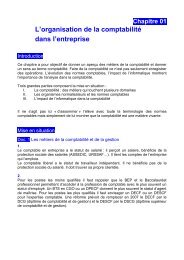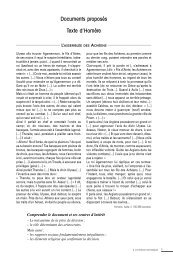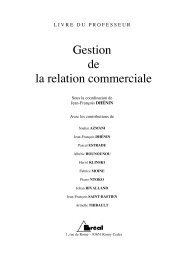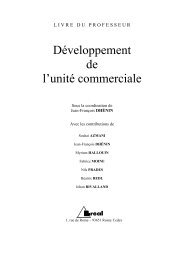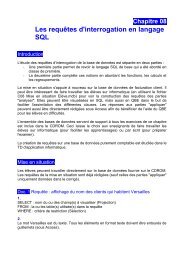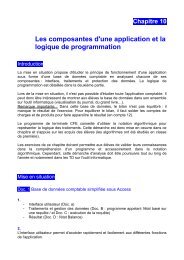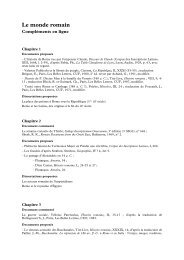correction exercices Précis de Physique-Chimie chapitre 5 à 9
correction exercices Précis de Physique-Chimie chapitre 5 à 9
correction exercices Précis de Physique-Chimie chapitre 5 à 9
Create successful ePaper yourself
Turn your PDF publications into a flip-book with our unique Google optimized e-Paper software.
Exercices et extraits d’annales<br />
Exercice 5 : Extrait du BTS Travaux Publics 2003<br />
1. Il s’agit d’une erreur, cette question est à supprimer.<br />
2.<br />
2.1. Le sens <strong>de</strong> la réaction est justifié à l’ai<strong>de</strong> <strong>de</strong> la règle du gamma. L’ion permanganate joue le rôle<br />
d’oxydant.<br />
2.2. Voir §6 <strong>de</strong> ce <strong>chapitre</strong>.<br />
2.3.<br />
- 2+ 2- +<br />
4<br />
+<br />
2<br />
+<br />
2<br />
= +<br />
4<br />
+<br />
2 MnO 5 SO 2 H O 2 Mn 5 SO 4 H<br />
2.4. A l’équivalence, la relation <strong>de</strong>s proportions stœchiométriques permet <strong>de</strong> trouver le facteur 5/2.<br />
3.<br />
3.1. Voir §6 <strong>de</strong> ce <strong>chapitre</strong>.<br />
3.2. CSO<br />
2<br />
= 5,0.10 mol.<br />
L<br />
−2 −1<br />
Exercice 6 : Extrait du BTS Travaux Publics 1995<br />
1. L’application <strong>de</strong> la règle du gamma permet <strong>de</strong> montrer que l’oxydant est l’ion permanganate tandis que le<br />
réducteur est le dioxy<strong>de</strong> <strong>de</strong> soufre. Voir §6 <strong>de</strong> ce <strong>chapitre</strong> pour le repérage <strong>de</strong> la fin <strong>de</strong> réaction.<br />
2. La relation <strong>de</strong>s proportions stœchiométriques à l’équivalence permet <strong>de</strong> trouver la relation entre les <strong>de</strong>ux<br />
quantités <strong>de</strong> matière.<br />
n<br />
−<br />
MnO4<br />
= 62,5.10<br />
−6<br />
mol<br />
3. nSO<br />
2<br />
= 156.10<br />
−6<br />
mol<br />
4. nSO<br />
' = 7,81.10<br />
2<br />
−3<br />
mol<br />
5. m<br />
S<br />
= 0, 25 g<br />
Cette masse est inférieure au 0,3 g requis par la législation. La teneur en soufre est donc conforme à la loi.<br />
Exercice 7 : Extrait du BTS Bâtiment 2004<br />
1. La donnée <strong>de</strong>s potentiels (qui en fait ne sont pas standards pour le couple O 2 /OH - ) montre que l’oxydant le plus<br />
fort est O 2 .<br />
2.<br />
3<br />
Al + + 3e − = Al<br />
O +2H O + 4e − = 4HO<br />
3. 2( g ) 2 ( l )<br />
−<br />
( aq)<br />
Eléments <strong>de</strong> <strong>correction</strong> <strong>de</strong>s <strong>exercices</strong> du <strong>chapitre</strong> 6 : Oxydoréduction : application à la protection contre la corrosion et aux dosages rédox ■ 45



